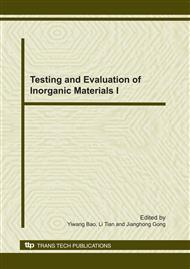p.215
p.219
p.223
p.226
p.231
p.235
p.238
p.245
p.249
Steady Thermal Stress in a Ceramic/FGM/Metal Composite EFBC Plate Considered Temperature Dependency
Abstract:
The steady thermal stress distributions and effect factors in a ceramic/FGM/metal composite EFBC plate with temperature-dependent material properties during heating process were investigated by the NFEM and the Sinpson method. From numerical calculation, when T0=Ta=300K and Tb=1 300K, the stress distributions in the plate were obtained. The results are as follows. With the increase of the FGM layer thickness, the stress distribution in the composite plate is more reasonable. Compared with M=0.1, when M=10, the compressive stress on the ceramic surface increases by 9.0%, and the tensile stress on the metal surface reduces by 17.9%. With the increase of FGM layer porosity, the variations of thermal stress curves become big. Compared with A=0, when A=3.99, the tensile stress on the metal surface increases by 65.5%, and the maximum compressive stress on the surface of ceramics reduces by 27.5%. Compared with the results of constant material properties, when we consider the temperature dependency of the material properties, the maximum tensile stress on the surface of metal in the plate reduces by 30.1%, and the maximum compressive stress on the surface of ceramics in the plate reduces by 9.49%. Compared with the nongraded two-layered plate, the tensile stress at middle of the graded three-layered composite EFBC plate reduces by 53.5%. When T0=300K, Ta=700K, compared with Tb=1 050K, when Tb=1 800K, the tensile stress on the surface of metal increases 563MPa, and the maximum compressive stress on the surface of ceramics increases 7.24 times.
Info:
Periodical:
Pages:
231-234
Citation:
Online since:
December 2010
Authors:
Price:
Сopyright:
© 2011 Trans Tech Publications Ltd. All Rights Reserved
Share:
Citation:


